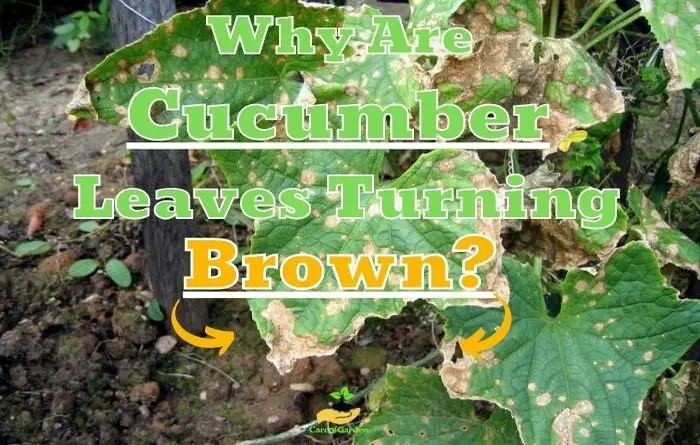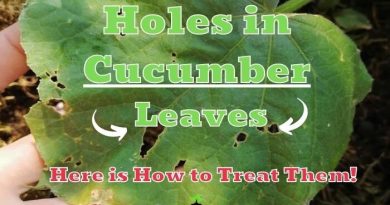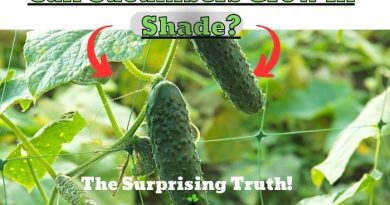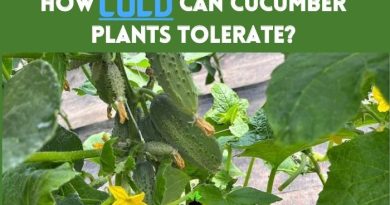Why Are Cucumber Leaves Turning Brown? (Easy Explanation)
It is pretty rewarding to have a cucumber plant in your house. You can make lemonade with fresh cucumber slices to beat the summertime heat. However, sometimes you see your cucumber leaves turning brown.
Overwatering, nutrient deficiencies, poor soil, fungal or bacterial diseases can all result in brown leaves on cucurbits plants. Environmental stressors such as high heat, low humidity, and direct sunlight can also cause cucumber leaves to turn brown. Proper watering, good air circulation, regular inspections, proper growing conditions, and the use of pesticides and fungicides can help prevent cucumber leaves from turning brown.
Knowing the causes of the issue and how to resolve it is preferable to simply sitting and stressing. Here are some tips to keep your cucumber plant’s leaves from turning brown. But let’s first identify the reasons why they are turning brown.
7 Reasons Why Cucumber Leaves Are Turning Brown
Cucumbers are summer-growing, water-loving plants that are really good for your body. It contains a lot of water and a few calories. The leaves of your cucumber plants may become brown for a number of causes, including the ones listed below.
1. Incorrect Watering Schedule
As thirsty as cucumber plants are, they require significantly more water throughout the summertime. But if you overwater your cucumber plant, that will lead to leaves turning brown.
For example, if the plant is underwatered, it will attempt to draw moisture from its leaves, which will cause the leaves to wilt and turn brown. Another frequent reason for browning cucumber leaves is overwatering.
Overwatered cucumber roots will need to be able to absorb nutrients more efficiently. This may result in withering or stunting, which in turn causes the leaves of your cucumbers to show signs of dehydration.
A common watering mistake that can lead to brown cucumber leaves is using water that is too cold. The cucumber plant can suffer a cold shock. The plant can absorb less water through the roots, which means that the leaves are no longer properly supplied and eventually die.
Treatment for Overwatering and Underwatering
Check the soil before watering if you think that overwatering is to blame for the browning of your cucumber leaves. It’s time to water if the top inch of the soil is dry.
How to properly water cucumbers:
- Always keep the soil slightly moist
- Preferably water in the morning
- If possible, do not wet the leaves
- Use tempered water
Be sure you water the plant from the base and stay away from the leaves. But keep in mind that the soil has to be regularly wet with an inch of water each week if the plant is underwater.
Always keep in mind how crucial consistency is when watering. Two daily dosages of automated watering can be set up for the early morning and late evening.
Also, it’s critical to check the drainage around your cucumber plants. The cucumber will die if the roots are submerged in water because they will suffocate. Sand or perlite can be added to the soil to help with drainage.
2. Fungal Infections
A fungal infection is the second possible explanation for your cucumber leaves turning brown. The most prevalent form of the fungus that attacks cucumber leaves is called blight, and it can result in brown or yellow spots on the leaves.
It is common in regions with warm temperatures and regular rainfall to have Alternaria Blight/Spot, which is brought on by Alternaria cucumerina. After surviving the winter, the fungus’ spores can re-infect plants in the spring.
Treatment for Fungal Infection
Crop rotation and good garden hygiene measures aid in the prevention of sticky stem blight. Do not replant cucumbers in the same spot after removing all dead plant material from the garden.
| Year | Crop | Previous Crop | Benefits |
|---|---|---|---|
| 1 | Brassicas | No cucurbits or related crops | Helps to break disease cycle |
| 2 | Legumes | Cucumbers | Fixes nitrogen and improves soil health |
| 3 | Grains | Legumes | Not related to cucumbers, helps to break disease cycle |
| 4 | Cover crops | Grains | Improves soil health and suppresses fungal pathogens |
Warm, humid weather is typically when fungus problems arise. To prevent cucumber leaf fungus, water your plants in the morning so that they have time to dry before dark.
Do not water from above, as this might spread the fungus. If you discover any brown or yellow patches on the leaves, remove them immediately.
Anthracnose (Colletotrichum orbiculare)

Anthracnose is another common cucumber disease that causes brown, necrotic spots on leaves, stems, and fruit. This is also a fungal disease, caused by a parasitic fungus called Colletotrichum orbiculare.
This disease causes the formation of brownish-red round spots 0.3 to 3-4 cm in diameter, isolated or in groups , with a well-defined outline. As the disease progresses, holes may form in the center of the brown spots.
In addition, a fluff covers the withered shoots. In the final stage, the entire plant eventually dries up. Even new fruit sets fall victim to the fungus.
In appearance, anthracnose resembles cucurbit scab and downy mildew. The disease affects all organs of the cucumber. Initially, it appears on seedlings. Brownish dents form on the root neck of the seedlings, and then the tender shoots begin to break and the plant dies completely.
Anthracnose affects cucumber plants that are densely planted in a greenhouse with poor ventilation and lack of lighting. Also, with improper nutrition, cucumber plants often suffer from this disease, especially with an excess of nitrogen and a lack of phosphorus and potassium.
Note: The infected cucumbers should definitely be quarantined. Insects or rainwater seeping into the ground lead to the spread of the fungus. After working on the cucumbers, the gardener must therefore thoroughly clean all the tools.
Treatment
The main treatment to be carried out is the implementation of long crop rotations, possibly using varieties of cucumbers not susceptible to this disease.
As soon as its appearance is noticed, the infected cucumber leaves must be removed as soon as possible. These can be burned by fire so that no trace of this disease is left.
You should dispose of these in household waste. The fungus spreads further on the compost, possibly returning to cucumber leaves or affecting other vegetable leaves.
Table with cucumber varieties that are resistant to Anthracnose
| Cucumber Variety | Anthracnose Resistance |
|---|---|
| Sweet Slice | Resistant |
| Carolina | Resistant |
| Salad Bush | Resistant |
| Straight Eight | Resistant |
| Arkansas Little Leaf | Resistant |
| Diva | Resistant |
| Eversweet | Resistant |
| Slice Master | Resistant |
| Calypso | Resistant |
| Bush Champion | Resistant |
To combat cucumber anthracnose, home remedies are ineffective, but still, if you do not use chemical insecticides in your garden, there are several remedies that can help stop the development of the disease:
- Spraying with a solution of baking soda. To prepare it, you need to mix 1 cup of soda with 10 liters of water. Also, for better adhesion to the leaves, it is recommended to add a little liquid soap to the mixture.
- Using garlic infusion. To do this, take 0.5 kg of garlic cloves or arrows, pour 5 liters of warm water, cover and leave overnight. In the morning, strain the solution and add 2-3 tablespoons of liquid soap to it.
To treat anthracnose, plantings are treated with a 1% solution of Bordeaux liquid or a 0.4% solution of copper chloride. This treatment procedure should be repeated every three days until the signs of the disease stop appearing.
Downy Mildew (Peronospora cubensis)

Out of all cucumber diseases, this is one of the most common. It affects the leaves of the plant and there is the formation of brown-yellow spots on the upper page while a brown mold forms on the lower one in correspondence with the spots .
As the disease progresses, the leaves may dry out and fall off. It is a disease very similar to that of grapevines, but the fungus responsible, Pseudoperonospora cubensis, is part of a different species.
Pseudoperonospora cubensis affects only cucurbits, mainly cucumber and melons, and a few wild host plants including climbing or wild cucumber ( Echinocystis lobata ).
Downy mildew mainly attacks cucumbers or pickled cucumbers that are grown in the garden or in a greenhouse. You can recognize it by the light green to yellow-brown spots on the cucumber leaves, which are particularly evident in the summer months.
Over time, the spots turn brown, and grayish-purple fungal spores form on the reverse side of the leaves. As a result, the cucumber leaves turn completely brown but usually do not die.
Treatment
Downy mildew can spread extremely quickly. To ensure that downy mildew does not spread to all plants, you should destroy infested leaves immediately.
1)Spraying with soda solution. To prepare it, you need to mix 5 liters of hot water with 25 g of soda and 5 g of liquid soap. After the mixture has cooled, you can immediately start spraying the plants and the soil around them. Treatment can be carried out 2-3 times with an interval of 7 days.
2)Wood ash solution. Take 2 cups of ash and sift thoroughly. So that there are no large particles. Then fill the ashes with 3 liters of water and let it brew for 2-3 hours. Before spraying, the solution must be filtered through gauze.
In order to prevent the disease, you should pay attention to resistant varieties when buying. You should avoid high humidity in the greenhouse and therefore ventilate it regularly.
Table with cucumber varieties that are resistant to Downy Mildew
| Cucumber Variety | Resistance to Downy Mildew |
|---|---|
| Marketmore 76 | Resistant |
| Tasty Green | Resistant |
| Sweet Success | Resistant |
| Dasher II | Resistant |
| Diva | Moderate resistance |
| Salad Bush | Moderate resistance |
| Straight Eight | Moderate resistance |
| Sweet Slice | Moderate resistance |
| Bush Champion | Susceptible |
| Ashley | Susceptible |
Angular Leaf Spot
Angular leaf spot is a bacterial infection caused by Pseudomonas syringae pv. Lachrymans. As with the anthracnose, watery spots appear, but they have a strikingly angular shape. In addition, the cucumber leaves will turn brown and dry while the cucumbers will squirm. A layer of mucus can also form on the shoots.
At high humidity and temperatures above 24 degrees, angular glassy-yellow spots appear on the cucumber leaves, which increase in size, then turn brown, dry up and finally fall out.
Angular leaf spot affects cucumis sativus at any stage of development and growth. At the stage of growing seedlings, yellow, then brown spots are visible on the cucumber seedlings.
Infection often appears from the lower or cotyledon leaves. Single wet spots of an angular shape are formed on the underside of the plate.
The causative agent of the disease is transferred to the plant by rain, wind, the remains of infected vegetation, contaminated tools during pruning. A two-week drought completely stops the development of the disease.
Treatment
In order to prevent angular leaf spot disease, you should ventilate the greenhouse regularly.
In the garden, a regular rotation of crops is important, because the leaf spot disease only affects cucurbits.
If there has been an infestation, you should avoid growing plants from this family in the same spot for at least three years.
Unfortunately, an infected cucumber cannot be saved. Since the bacteria remain in the soil, the gardener should pause for three years before growing a cucumber plant again in the same location.
Table with cucumber varieties that are resistant to Angular Leaf Spot
| Cucumber Variety | Angular Leaf Spot Resistance |
|---|---|
| Dasher II | Resistant |
| Sweet Success | Resistant |
| Marketmore 76 | Resistant |
| General Lee | Resistant |
| Olympian | Resistant |
| Raider | Resistant |
| Saladin | Resistant |
| Tyria | Resistant |
| Tasty Green | Resistant |
| Striker | Resistant |
3. Bacterial Wilt
Another frequent problem in gardens is bacterial wilt. A soil-borne bacteria that affects plant roots and leaves is to blame for its development. Cucumbers that have been infected start to wilt and turn brown, sometimes starting with a few vines before spreading to the entire plant.
Cutting a wilted stem off at the base and touching the cut with your fingers is easy to verify if the cucumber problem you’re dealing with is bacterial wilt. If white, fine, thread-like strands emerge from the cutting, your plants have bacterial wilt. Sadly, bacterial wilt cannot be treated.
Treatment for Bacterial Wilt
Get rid of any damaged cucumber plants right once to prevent bacterial wilt from engulfing your patch and posing a severe threat to cucumber farmers since it may swiftly spread through your whole crop if left untreated.
Affected cucumber leaves are destroyed, others are treated with a 0.2% solution of copper sulfate according to the instructions.
In the future, for the purpose of prevention, it is recommended to disinfect the seed material by soaking it in a dark pink solution of potassium permanganate for half an hour before sowing.
Keep the cucumber beetle under control to avoid bacterial wilt. To stop the germs from spreading, add water to the base.
4. Nutrient Deficiencies
Cucumber leaves need many nutrients to stay healthy. They’ll begin to turn brown if they don’t obtain enough of these nutrients. Nitrogen and potassium deficiency is the most frequent nutritional deficit resulting in cucumber leaves browning.
- Nitrogen Deficiency: The cucumber plants watering, which causes its leaves to become brown or black, is the first and most typical cause. As too much water is absorbed into the soil, overwatering weakens the roots of plants. Molds form along the sidewalls of the roots as a result of too much water, damaging the root and stifling its growth.
- Potassium Deficiency: Potassium insufficiency results from an increase in nitrogen deficit when it reaches the inner roots, where the plant requires more potassium to thrive. Many illnesses affect cucumbers that are growing in a potassium-deficient environment. For the division of cells and the transformation of energy, phosphorus is essential.
- Magnesium Deficiency: Having too much potassium, ammonium, or calcium might result in a magnesium deficit. Magnesium, like nitrogen, is essential for the synthesis of chlorophyll and photosynthesis.
| Nutrient Deficiency | Function | Symptoms |
|---|---|---|
| Nitrogen | Aids in plant growth and chlorophyll production | Older leaves turn yellow, then brown starting at the tips, while younger leaves remain green |
| Potassium | Helps regulate water balance and aids in fruit development | Yellowing between leaf veins, followed by browning and death of leaf tissue, starting at the edges and tips |
| Calcium | Essential for plant cell wall development and plant growth | Newer leaves show curling or distortion, and older leaves turn yellow and then brown, while still attached to the plant |
| Magnesium | Essential for chlorophyll production | Yellowing between leaf veins, followed by browning and death of leaf tissue, starting at the edges and tips |
| Boron | Aids in plant reproduction and root development | Browning at the tips and margins of leaves, followed by cracking and splitting of the stem near the fruit |
| Manganese | Aids in enzyme function and chlorophyll production | Yellowing between leaf veins, followed by browning and death of leaf tissue, starting at the edges and tips |
The nutrients not only form the basis for growth, the plant also needs them to form the green color in the leaves. If this is missing, photosynthesis is no longer possible, which means that more and more cucumber leaves turn brown and the plant ultimately dies.
Treatment for Nutrient Deficiencies in Cucumber Plant
If you suspect that a nutrient shortage is to blame for the browning of your cucumber leaves, examine the soil and apply amendments as necessary.
Use nitrogen fertilizer to treat chlorosis since it will adequately hydrate the soil and guard against root damage.
Potassium fertilizer is available that adjusts the potassium ratio required by plants. It would be best if you had magnesium-rich minerals in the soil to address the magnesium deficit.
How to ensure the nutrient supply of the cucumber plants:
- Basic fertilization with compost or manure before planting
- Use slow-release fertilizers such as horn shavings
- Apply liquid fertilizer such as nettle manure every two weeks after fruit formation
5. Poor Soil Conditions
Insufficient soil nutrients may result in brown leaves. Your cucumbers will most likely develop a disease if they are planted in non-sterile soil.
Meaning that cucumber plants are extremely susceptible to infections if the soil is deficient in nutrients or is not sterilized. These illnesses can result in stem rot, mottled leaves, and dark and discolored leaves.
Treating Poor Soil Conditions
Cut the diseased leaves off the plant and burn them if the soil hasn’t been sanitized and your cucumber leaves are turning brown. Sadly, once the leaves have turned color, there is no turning them back.
You can stop the spread by removing the affected cucumbers and leaves. Plant your cucumbers in sterile soil, such as potting soil.
6. Heat
By the way, not only cold and humidity can cause the appearance of brown spots on cucumbers. Sometimes the scorching sun becomes the reason. Dew drops that fall on the cucumber leaf reflect the sun’s rays, and dry burnt spots appear on them.
The leaves are pressed tightly against the greenhouse and fade in the sun. In such cases, it is enough to shade the whips, and everything will work out.
Heat stroke can especially affect young cucumber leaves that are planted in the greenhouse. The delicate plants are not used to the high temperatures that prevail there and react by turning their leaves brown.
Treatment
How to prevent heat damage:
- Slowly get the young plants used to the temperatures
- Shade the greenhouse during the midday heat
- Water several times throughout the day
- Leave the greenhouse door open on hot days
Note: young cucumber plants in the field get sunburn easily, since they are not used to the direct sun. First place the cucumbers in the shade and slowly acclimate them to the sun. This way you can prevent the cucumber leaves from turning brown.
7. Aphids
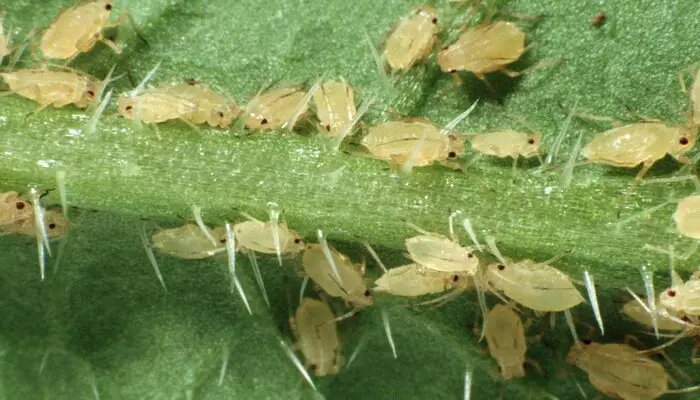
One of the pests that may harm your cucumber plants is aphids. These insects may be found on the underside of leaves and stem, where they feed and suck leaf sap.
As aphids gather in large groups, your cucumber’s leaves turn from green to yellow to brown before finally dying off altogether. There are black or brown necrotic areas on the surface, and the plant’s sections could feel sticky. The honeydew is what causes aphids to secrete.
Aphids are at work on cucumber plants, as they are everywhere in the garden. The green to light brown aphids colonize the plants as early as early summer and suck on the leaves and flower buds. The result is short stature and the risk of sooty mold entering.
Treating Aphids
Look for tiny bugs on the underside of the leaves if you think pests are to blame for the browning of your cucumber leaves. They could even be tucked away in the cracks.
If you detect pests, you may either manually get rid of them or use an organic insecticide to get rid of them. Be sure to remove all diseased areas with pruning.
The best way to fight aphids is with their natural enemies such as ladybird larvae, lacewing larvae and hoverflies.
How to Prevent Cucumber Leaves from Turning Brown
Cucumber plants are typically disease-resistant and simple to cultivate, but they do need frequent watering, fertilizer, and lots of sunshine. Make sure your cucumber plant receives adequate water.
Browning of leaves can be brought by either insufficient or excessive watering. Add fertilizer once a week to encourage new growth for cucumbers that appear healthy as they develop into fruit later on.
Cucumber plants should only be planted outside once they are no longer frosty; also, ensure the plants are not exposed to nighttime winds or cold gusts. If your cucumber plant’s leaves are brown, it may be because it’s too chilly or exposed to a draft.
All cucumber plants, whether grown inside or outdoors, require at least 5 hours of sunlight every day (more is preferable) and a temperature of at least 70°F (21°C). But, if leaves are brown indoors, they might be from sunburn.
Table outlining some tips on how to prevent cucumber leaves from turning brown
| Prevention Tips | Description |
|---|---|
| Watering | Ensure that the cucumber plant is adequately watered, but not overwatered. Too much water can lead to root rot and fungal diseases that cause the leaves to turn brown. |
| Fertilizing | Use a balanced fertilizer to provide essential nutrients to the plant, including nitrogen, which is crucial for leaf development. Be sure not to over-fertilize, as this can lead to burned leaves. |
| Pruning | Remove any yellow or brown leaves as soon as possible to prevent the spread of disease. Pruning also helps to promote air circulation around the plant and prevent moisture buildup. |
| Pesticides | Use organic or chemical pesticides to prevent pests and diseases that can cause brown leaves. Be sure to follow the instructions on the label carefully and apply as needed. |
| Sunlight | Ensure that the cucumber plant is getting enough sunlight, but not too much. Too much sunlight can cause the leaves to wilt and turn brown, while too little can stunt the cucumber plant’s leaf growth. |
Should I cut off brown cucumber leaves?
If you notice that only a few cucumber leaves are turning brown, it is a good idea to remove them to stop any further spread.
I advise you to remove cucumber leaves as soon as they start to turn brown due to fungal disease in order to stop the disease from spreading to healthy sections of the plant.
The leaves might not recover even if you cut them off if the browning is caused by a lack of nutrients or water. In this instance, it is essential to concentrate on giving the plant enough water and nutrients to stop additional browning.
Before deciding whether to remove the leaves, it is therefore advisable to identify the underlying reason why leaves are turning brown.
Conclusion
Firstly, there are many potential causes of brown cucumber leaves, including overwatering, nutrient deficiencies, diseases, pests, and environmental stressors.
Secondly, proper watering, good air circulation, regular inspections, and appropriate growing conditions can all help prevent cucumber leaves from turning brown.
Thirdly, using pesticides, fungicides, or other treatments can be effective in controlling pests and diseases that may cause the leaves to turn brown.
Overall, if you are experiencing brown cucumber leaves, it is important to assess and address the underlying cause in order to maintain the health and productivity of your cucumber plants. By taking proactive steps to prevent and treat issues, you can ensure that your cucumber plants thrive and produce a bountiful harvest.
Frequently Asked Questions
Yes, there are several home remedies you can use to treat brown cucumber leaves. For example, you can apply a mixture of equal parts milk and water to the leaves, as the calcium in milk can help prevent further browning. You can also apply a mixture of baking soda and water, as baking soda can help prevent the spread of fungal diseases.
Yes, overwatering can lead to brown cucumber leaves. When soil is too wet, it can prevent the plant roots from getting enough oxygen, which can cause root rot and lead to browning leaves.
No, it is not normal for cucumber leaves to turn brown. While some yellowing or browning of leaves may occur naturally as the plant ages, widespread browning or discoloration is a sign of a problem.
Cucumber leaves can turn brown due to various reasons such as overwatering, fungal or bacterial diseases, nutrient deficiencies, poor soil, pests, and environmental stressors. Overwatering can cause root rot, while diseases such as powdery mildew or bacterial wilt can cause brown spots on the leaves. Pests like spider mites, aphids, and cucumber beetles can damage the leaves, causing them to turn brown. Environmental stressors such as high heat, low humidity, and direct sunlight can also lead to brown leaves. Proper watering, good air circulation, regular inspections, and appropriate growing conditions can help prevent cucumber leaves from turning brown.

